Difficulties in language acquisition of english and japanese all at once
ABSTRACT
Our modern society with increasing demands for integration of economy and new technology
requires us to be proficient in certain commonly used languages as a prerequisite for graduates, as
well as to create higher job opportunities for applicants. Meanwhile, a set of considerable
differences regarding four aspects which are the alphabet, pronunciation, writing forms, and
communication styles, prevents learners from studying languages effectively. This study, aims to
better identify and arrive at a thorough understanding of the major difficulties in bilingual learning,
particularly English and Japanese, based on their major differences. The paper, furthermore, highly
recommends feasible solutions by being an autonomous learner and utilizing various available
supports. The study was conducted by synthesizing and analyzing a great number of scholarly
articles, journals and books. It is fully hoped that this study will motivate bilinguals to deny their fear
on the path of learning languages.
Keywords: English, Japanese, difficulties,
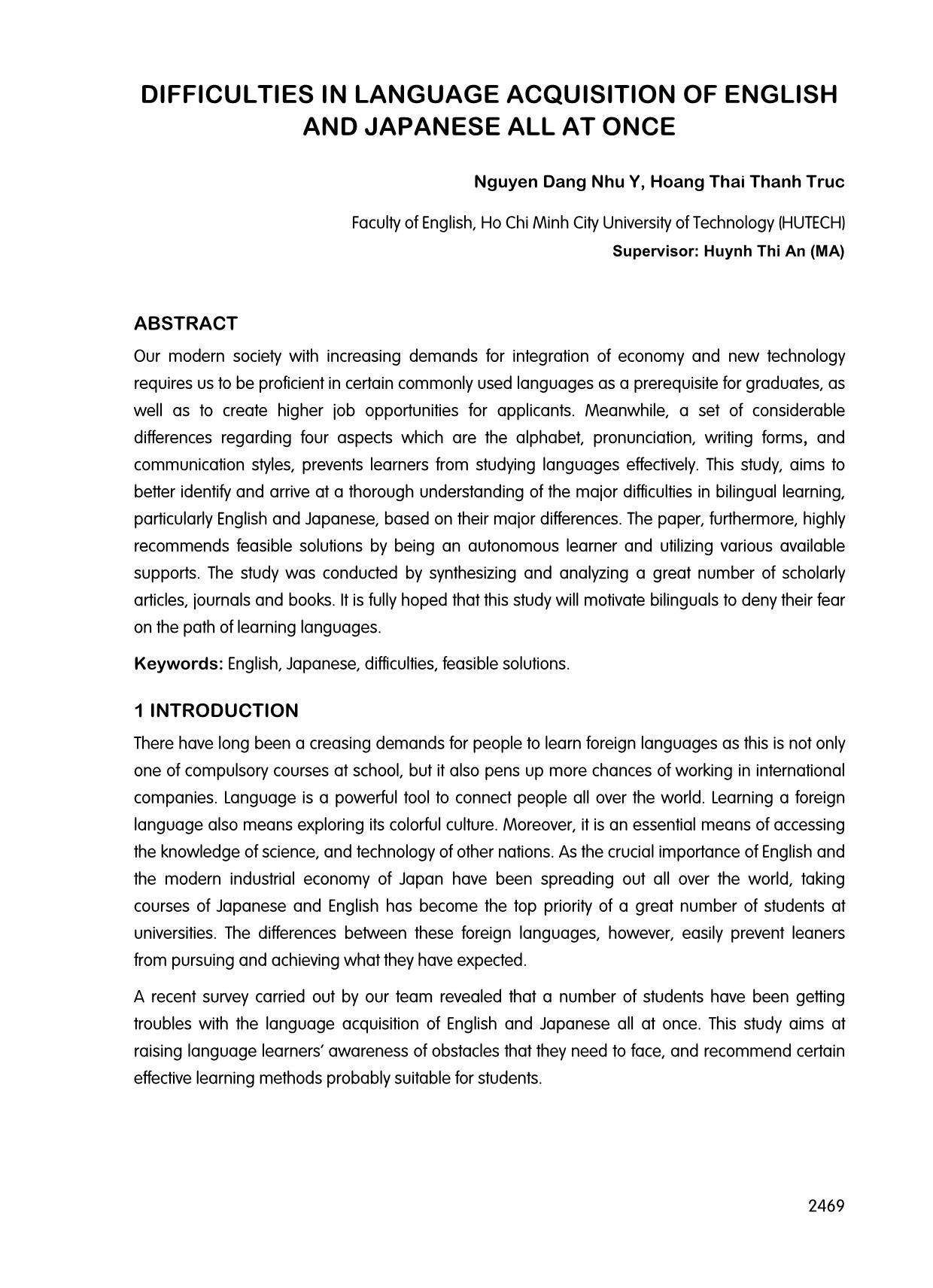
Trang 1
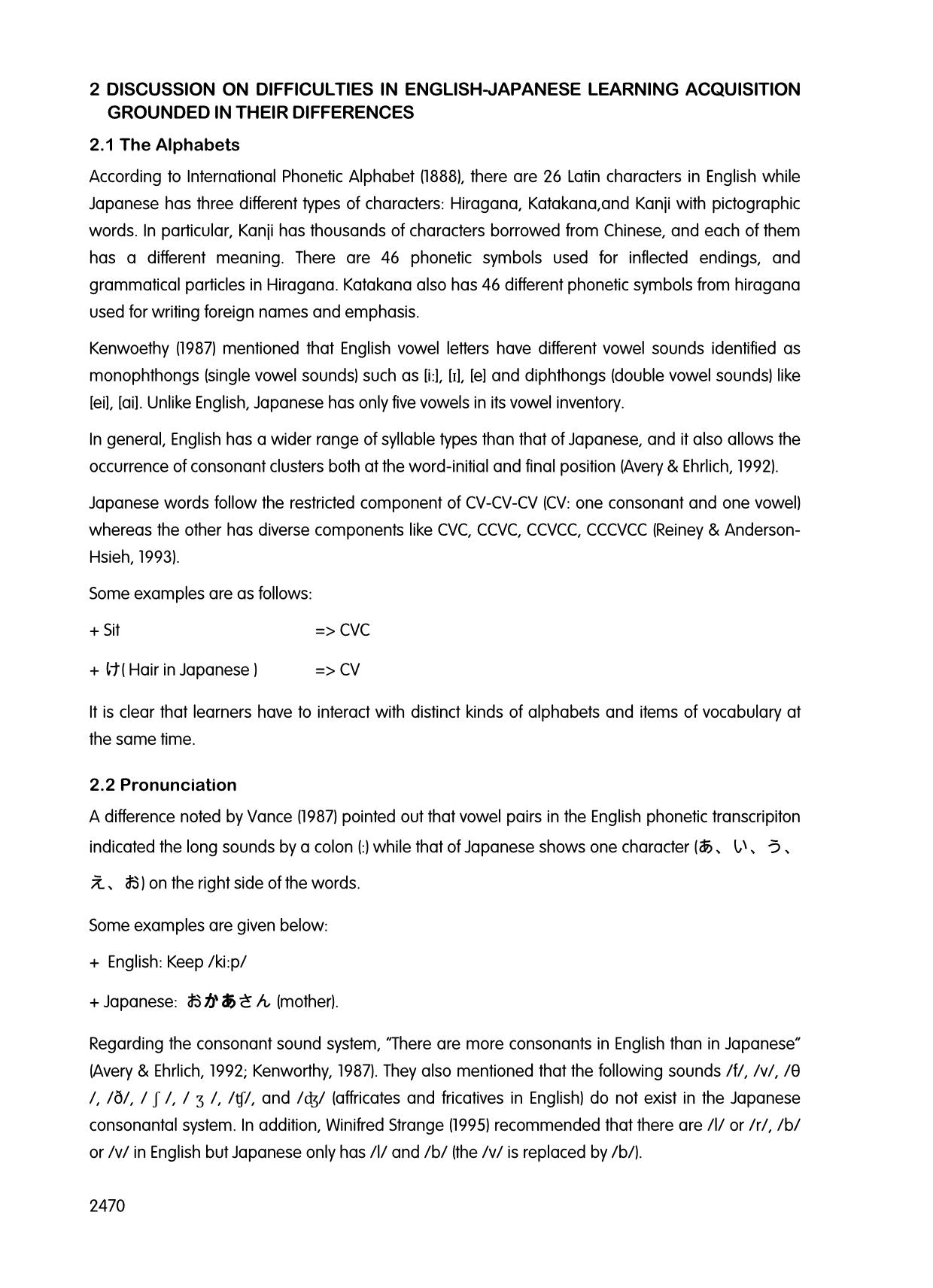
Trang 2
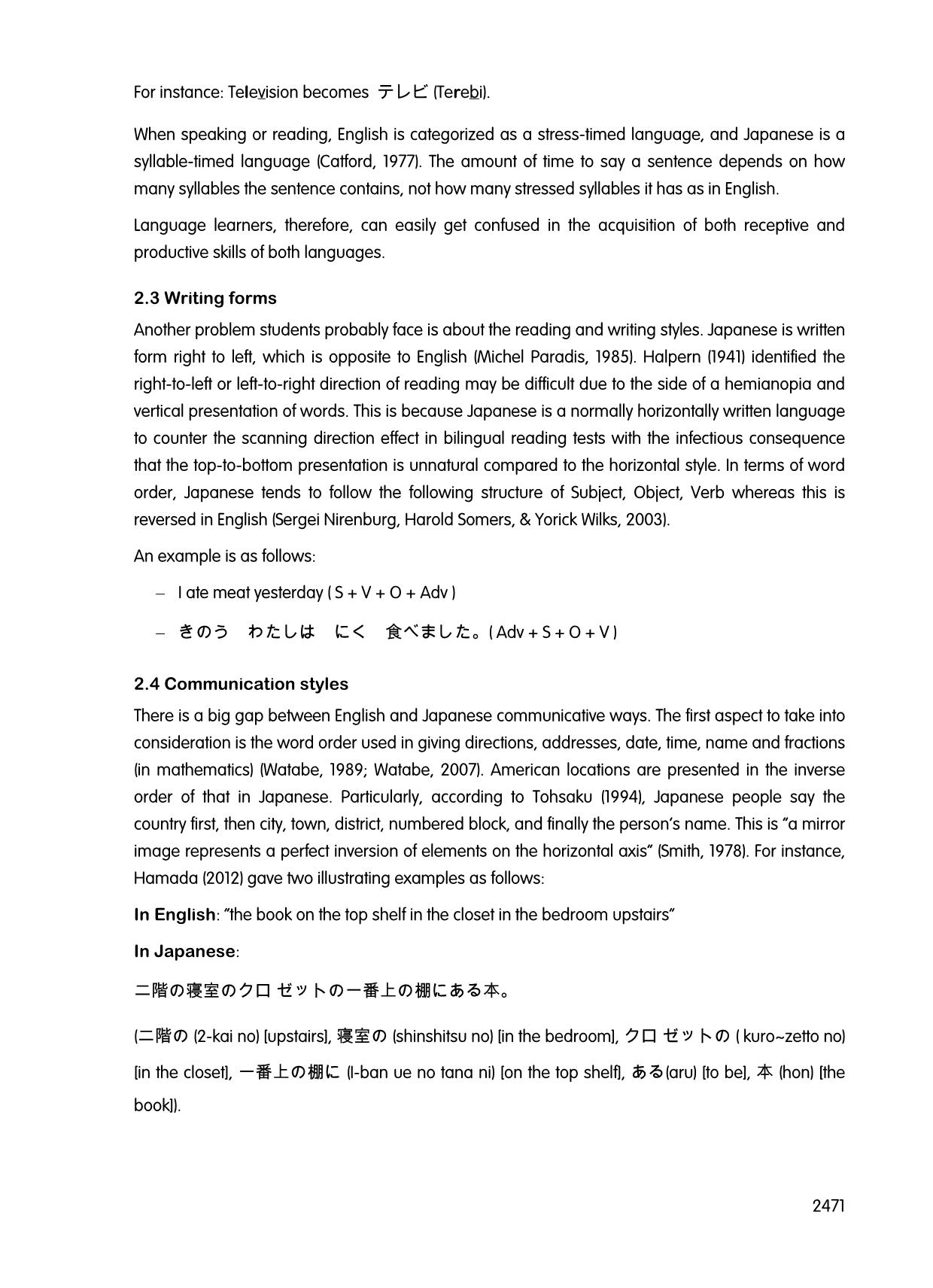
Trang 3
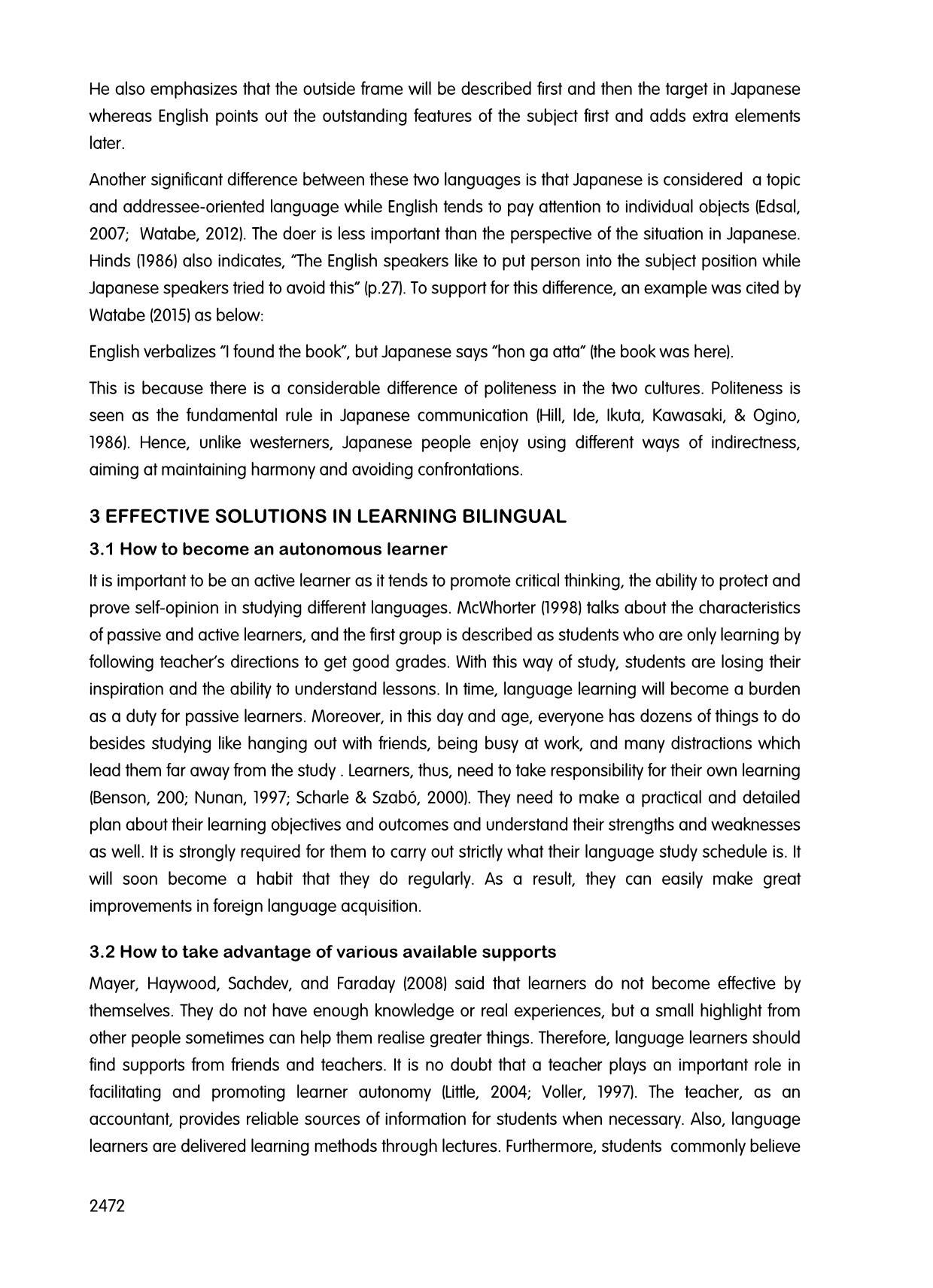
Trang 4
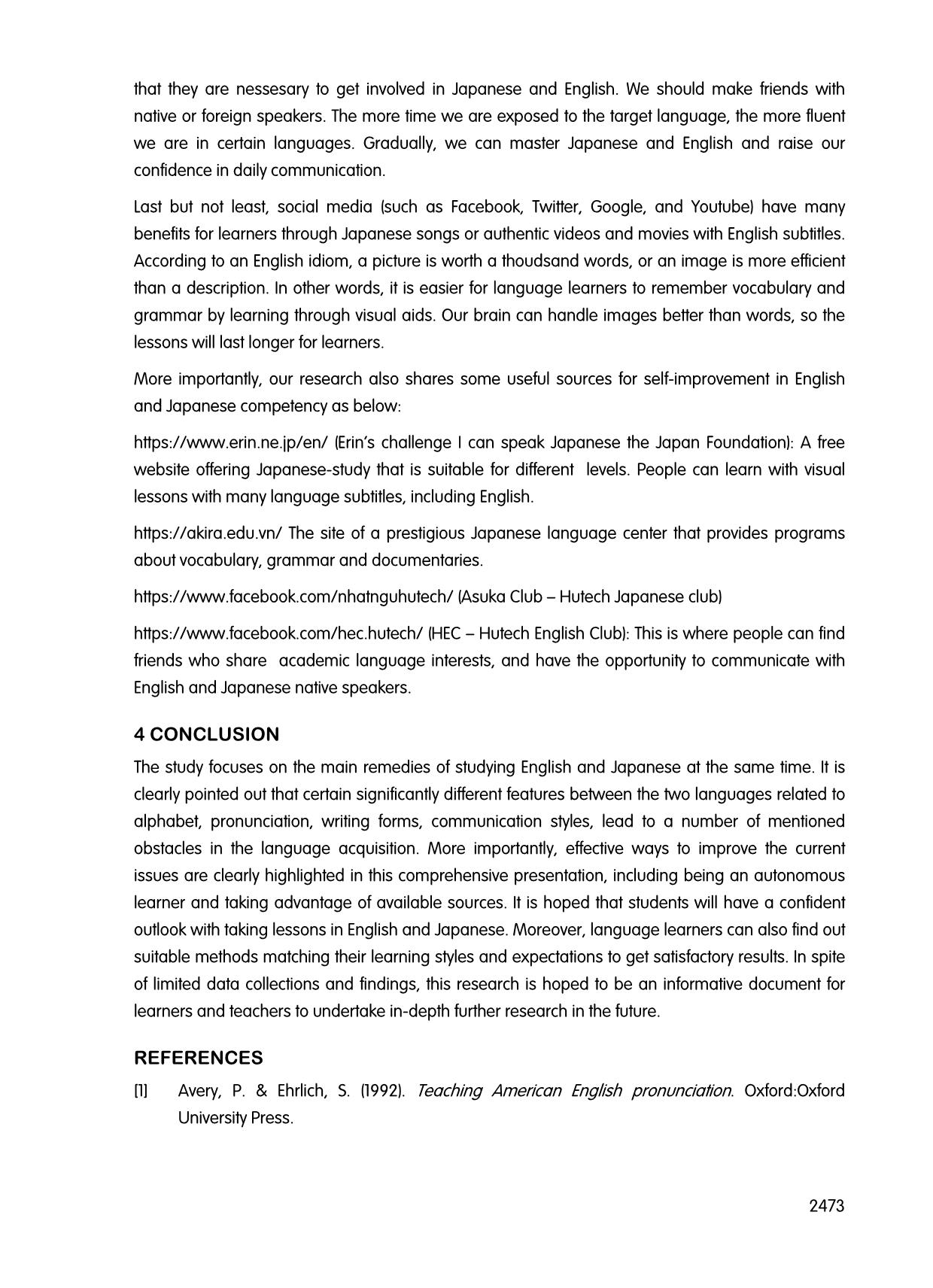
Trang 5
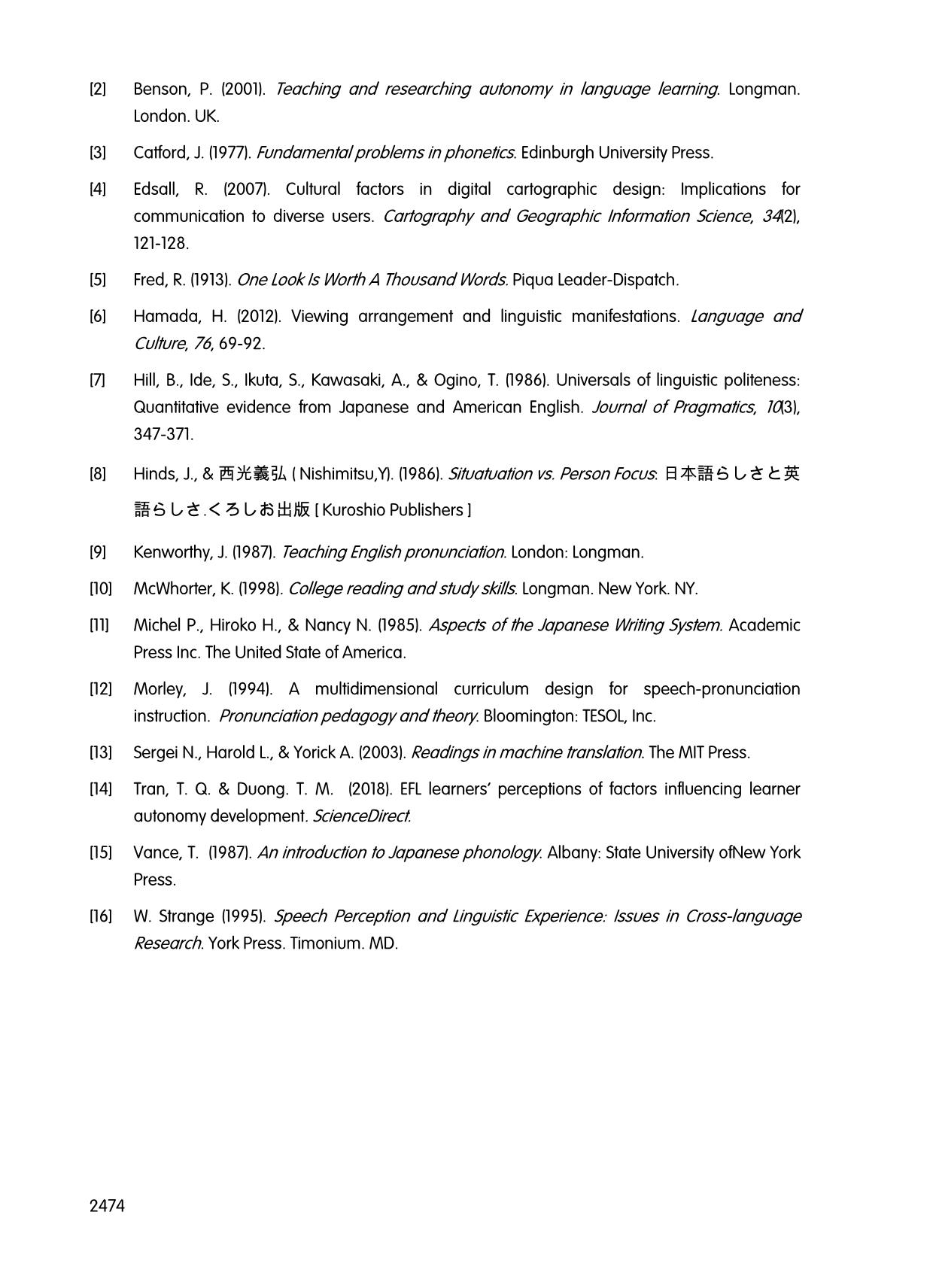
Trang 6
Tóm tắt nội dung tài liệu: Difficulties in language acquisition of english and japanese all at once
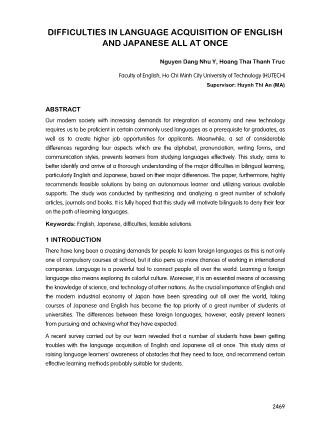
2469 DIFFICULTIES IN LANGUAGE ACQUISITION OF ENGLISH AND JAPANESE ALL AT ONCE Nguyen Dang Nhu Y, Hoang Thai Thanh Truc Faculty of English, Ho Chi Minh City University of Technology (HUTECH) Supervisor: Huynh Thi An (MA) ABSTRACT Our modern society with increasing demands for integration of economy and new technology requires us to be proficient in certain commonly used languages as a prerequisite for graduates, as well as to create higher job opportunities for applicants. Meanwhile, a set of considerable differences regarding four aspects which are the alphabet, pronunciation, writing forms, and communication styles, prevents learners from studying languages effectively. This study, aims to better identify and arrive at a thorough understanding of the major difficulties in bilingual learning, particularly English and Japanese, based on their major differences. The paper, furthermore, highly recommends feasible solutions by being an autonomous learner and utilizing various available supports. The study was conducted by synthesizing and analyzing a great number of scholarly articles, journals and books. It is fully hoped that this study will motivate bilinguals to deny their fear on the path of learning languages. Keywords: English, Japanese, difficulties, feasible solutions. 1 INTRODUCTION There have long been a creasing demands for people to learn foreign languages as this is not only one of compulsory courses at school, but it also pens up more chances of working in international companies. Language is a powerful tool to connect people all over the world. Learning a foreign language also means exploring its colorful culture. Moreover, it is an essential means of accessing the knowledge of science, and technology of other nations. As the crucial importance of English and the modern industrial economy of Japan have been spreading out all over the world, taking courses of Japanese and English has become the top priority of a great number of students at universities. The differences between these foreign languages, however, easily prevent leaners from pursuing and achieving what they have expected. A recent survey carried out by our team revealed that a number of students have been getting troubles with the language acquisition of English and Japanese all at once. This study aims at raising language learners’ awareness of obstacles that they need to face, and recommend certain effective learning methods probably suitable for students. 2470 2 DISCUSSION ON DIFFICULTIES IN ENGLISH-JAPANESE LEARNING ACQUISITION GROUNDED IN THEIR DIFFERENCES 2.1 The Alphabets According to International Phonetic Alphabet (1888), there are 26 Latin characters in English while Japanese has three different types of characters: Hiragana, Katakana,and Kanji with pictographic words. In particular, Kanji has thousands of characters borrowed from Chinese, and each of them has a different meaning. There are 46 phonetic symbols used for inflected endings, and grammatical particles in Hiragana. Katakana also has 46 different phonetic symbols from hiragana used for writing foreign names and emphasis. Kenwoethy (1987) mentioned that English vowel letters have different vowel sounds identified as monophthongs (single vowel sounds) such as [i:], [ɪ], [e] and diphthongs (double vowel sounds) like [ei], [ai]. Unlike English, Japanese has only five vowels in its vowel inventory. In general, English has a wider range of syllable types than that of Japanese, and it also allows the occurrence of consonant clusters both at the word-initial and final position (Avery & Ehrlich, 1992). Japanese words follow the restricted component of CV-CV-CV (CV: one consonant and one vowel) whereas the other has diverse components like CVC, CCVC, CCVCC, CCCVCC (Reiney & Anderson- Hsieh, 1993). Some examples are as follows: + Sit => CVC + け( Hair in Japanese ) => CV It is clear that learners have to interact with distinct kinds of alphabets and items of vocabulary at the same time. 2.2 Pronunciation A difference noted by Vance (1987) pointed out that vowel pairs in the English phonetic transcripiton indicated the long sounds by a colon (:) while that of Japanese shows one character (あ、い、う、 え、お) on the right side of the words. Some examples are given below: + English: Keep /ki:p/ + Japanese: おかあさん (mother). Regarding the consonant sound system, ‚There are more consonants in English than in Japanese‛ (Avery & Ehrlich, 1992; Kenworthy, 1987). They also mentioned that the following sounds /f/, /v/, /θ /, /ð/, / ʃ /, / ʒ /, /ʧ/, and /ʤ/ (affricates and fricatives in English) do not exist in the Japanese consonantal system. In addition, Winifred Strange (1995) recommended that there are /l/ or /r/, /b/ or /v/ in English but Japanese only has /l/ and /b/ (the /v/ is replaced by /b/). 2471 For instance: Television becomes テレビ (Terebi). When speaking or reading, English is categorized as a stress-timed language, and Japanese is a syllable-timed language (Catford, 1977). The amount of time to say a sentence depends on how many syllables the sentence contains, not how many stressed syllables it has as in English. Language learners, therefore, can easily get confused in the acquisition of both receptive and productive skills of both languages. 2.3 Writing forms Another problem students probably face is about the reading and writing styles. Japanese is written form right to left, which is opposite to English (Michel Paradis, 1985). Halpern (1941) identified the right-to-left or left-to-right direction of reading may be difficult due to the side of a hemianopia and vertical presentation of words. This is because Japanese is a normally horizontally written language to counter the scanning direction effect in bilingual reading tests with the infectious consequence that the top-to-bottom presentation is unnatural compared to the horizontal style. In terms of word order, Japanese tends to follow the following structure of Subject, Object, Verb whereas this is reversed in English (Sergei Nirenburg, Harold Somers, & Yorick Wilks, 2003). An example is as follows: – I ate meat yesterday ( S + V + O + Adv ) – きのう わたしは にく 食べました。( Adv + S + O + V ) 2.4 Communication styles There is a big gap between English and Japanese communicative ways. The first aspect to take into consideration is the word order used in giving directions, addresses, date, time, name and fractions (in mathematics) (Watabe, 1989; Watabe, 2007). American locations are presented in the inverse order of that in Japanese. Particularly, according to Tohsaku (1994), Japanese people say the country first, then city, town, district, numbered block, and finally the person’s name. This is ‚a mirror image represents a perfect inversion of elements on the horizontal axis‛ (Smith, 1978). For instance, Hamada (2012) gave two illustrating examples as follows: In English: ‚the book on the top shelf in the closet in the bedroom upstairs‛ In Japanese: 二階の寝室のクロ―ゼットの一番上の棚にある本。 (二階の (2-kai no) [upstairs], 寝室の (shinshitsu no) [in the bedroom], クロ―ゼットの ( kuro~zetto no) [in the closet], 一番上の棚に (I-ban ue no tana ni) [on the top shelf], ある(aru) [to be], 本 (hon) [the book]). 2472 He also emphasizes that the outside frame will be described first and then the target in Japanese whereas English points out the outstanding features of the subject first and adds extra elements later. Another significant difference between these two languages is that Japanese is considered a topic and addressee-oriented language while English tends to pay attention to individual objects (Edsal, 2007; Watabe, 2012). The doer is less important than the perspective of the situation in Japanese. Hinds (1986) also indicates, ‚The English speakers like to put person into the subject position while Japanese speakers tried to avoid this‛ (p.27). To support for this difference, an example was cited by Watabe (2015) as below: English verbalizes ‚I found the book‛, but Japanese says ‚hon ga atta‛ (the book was here). This is because there is a considerable difference of politeness in the two cultures. Politeness is seen as the fundamental rule in Japanese communication (Hill, Ide, Ikuta, Kawasaki, & Ogino, 1986). Hence, unlike westerners, Japanese people enjoy using different ways of indirectness, aiming at maintaining harmony and avoiding confrontations. 3 EFFECTIVE SOLUTIONS IN LEARNING BILINGUAL 3.1 How to become an autonomous learner It is important to be an active learner as it tends to promote critical thinking, the ability to protect and prove self-opinion in studying different languages. McWhorter (1998) talks about the characteristics of passive and active learners, and the first group is described as students who are only learning by following teacher’s directions to get good grades. With this way of study, students are losing their inspiration and the ability to understand lessons. In time, language learning will become a burden as a duty for passive learners. Moreover, in this day and age, everyone has dozens of things to do besides studying like hanging out with friends, being busy at work, and many distractions which lead them far away from the study . Learners, thus, need to take responsibility for their own learning (Benson, 200; Nunan, 1997; Scharle & Szabó, 2000). They need to make a practical and detailed plan about their learning objectives and outcomes and understand their strengths and weaknesses as well. It is strongly required for them to carry out strictly what their language study schedule is. It will soon become a habit that they do regularly. As a result, they can easily make great improvements in foreign language acquisition. 3.2 How to take advantage of various available supports Mayer, Haywood, Sachdev, and Faraday (2008) said that learners do not become effective by themselves. They do not have enough knowledge or real experiences, but a small highlight from other people sometimes can help them realise greater things. Therefore, language learners should find supports from friends and teachers. It is no doubt that a teacher plays an important role in facilitating and promoting learner autonomy (Little, 2004; Voller, 1997). The teacher, as an accountant, provides reliable sources of information for students when necessary. Also, language learners are delivered learning methods through lectures. Furthermore, students commonly believe 2473 that they are nessesary to get involved in Japanese and English. We should make friends with native or foreign speakers. The more time we are exposed to the target language, the more fluent we are in certain languages. Gradually, we can master Japanese and English and raise our confidence in daily communication. Last but not least, social media (such as Facebook, Twitter, Google, and Youtube) have many benefits for learners through Japanese songs or authentic videos and movies with English subtitles. According to an English idiom, a picture is worth a thoudsand words, or an image is more efficient than a description. In other words, it is easier for language learners to remember vocabulary and grammar by learning through visual aids. Our brain can handle images better than words, so the lessons will last longer for learners. More importantly, our research also shares some useful sources for self-improvement in English and Japanese competency as below: https://www.erin.ne.jp/en/ (Erin’s challenge I can speak Japanese the Japan Foundation): A free website offering Japanese-study that is suitable for different levels. People can learn with visual lessons with many language subtitles, including English. https://akira.edu.vn/ The site of a prestigious Japanese language center that provides programs about vocabulary, grammar and documentaries. https://www.facebook.com/nhatnguhutech/ (Asuka Club – Hutech Japanese club) https://www.facebook.com/hec.hutech/ (HEC – Hutech English Club): This is where people can find friends who share academic language interests, and have the opportunity to communicate with English and Japanese native speakers. 4 CONCLUSION The study focuses on the main remedies of studying English and Japanese at the same time. It is clearly pointed out that certain significantly different features between the two languages related to alphabet, pronunciation, writing forms, communication styles, lead to a number of mentioned obstacles in the language acquisition. More importantly, effective ways to improve the current issues are clearly highlighted in this comprehensive presentation, including being an autonomous learner and taking advantage of available sources. It is hoped that students will have a confident outlook with taking lessons in English and Japanese. Moreover, language learners can also find out suitable methods matching their learning styles and expectations to get satisfactory results. In spite of limited data collections and findings, this research is hoped to be an informative document for learners and teachers to undertake in-depth further research in the future. REFERENCES [1] Avery, P. & Ehrlich, S. (1992). Teaching American English pronunciation. Oxford:Oxford University Press. 2474 [2] Benson, P. (2001). Teaching and researching autonomy in language learning. Longman. London. UK. [3] Catford, J. (1977). Fundamental problems in phonetics. Edinburgh University Press. [4] Edsall, R. (2007). Cultural factors in digital cartographic design: Implications for communication to diverse users. Cartography and Geographic Information Science, 34(2), 121-128. [5] Fred, R. (1913). One Look Is Worth A Thousand Words. Piqua Leader-Dispatch. [6] Hamada, H. (2012). Viewing arrangement and linguistic manifestations. Language and Culture, 76, 69-92. [7] Hill, B., Ide, S., Ikuta, S., Kawasaki, A., & Ogino, T. (1986). Universals of linguistic politeness: Quantitative evidence from Japanese and American English. Journal of Pragmatics, 10(3), 347-371. [8] Hinds, J., & 西光義弘 ( Nishimitsu,Y). (1986). Situatuation vs. Person Focus: 日本語らしさと英 語らしさ.くろしお出版 [ Kuroshio Publishers ] [9] Kenworthy, J. (1987). Teaching English pronunciation. London: Longman. [10] McWhorter, K. (1998). College reading and study skills. Longman. New York. NY. [11] Michel P., Hiroko H., & Nancy N. (1985). Aspects of the Japanese Writing System. Academic Press Inc. The United State of America. [12] Morley, J. (1994). A multidimensional curriculum design for speech-pronunciation instruction. Pronunciation pedagogy and theory. Bloomington: TESOL, Inc. [13] Sergei N., Harold L., & Yorick A. (2003). Readings in machine translation. The MIT Press. [14] Tran, T. Q. & Duong. T. M. (2018). EFL learners' perceptions of factors influencing learner autonomy development. ScienceDirect. [15] Vance, T. (1987). An introduction to Japanese phonology. Albany: State University ofNew York Press. [16] W. Strange (1995). Speech Perception and Linguistic Experience: Issues in Cross-language Research. York Press. Timonium. MD.
File đính kèm:
 difficulties_in_language_acquisition_of_english_and_japanese.pdf
difficulties_in_language_acquisition_of_english_and_japanese.pdf

